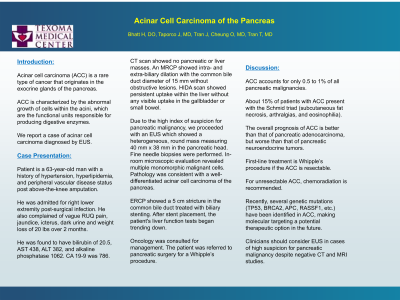Tuesday Poster Session
Category: Biliary/Pancreas
P3519 - Acinar Cell Carcinoma of the Pancreas
Tuesday, October 29, 2024
10:30 AM - 4:00 PM ET
Location: Exhibit Hall E

Has Audio
- JT
Jefferson Tran
TMC
Sherman, TX
Presenting Author(s)
Heli Bhatt, DO1, Jason Taporco, MD1, Jefferson Tran, 2, Onpan Cheung, MD1, Thomas Tran, MD1
1TMC, Denison, TX; 2TMC, Sherman, TX
Introduction: Acinar cell carcinoma (ACC) is a rare type of cancer that originates in the exocrine glands of the pancreas. ACC is characterized by the abnormal growth of cells within the acini, which are the functional units responsible for producing digestive enzymes. We report a case of acinar cell carcinoma diagnosed by EUS.
Case Description/Methods: Patient is a 63-year-old man with a history of hypertension, hyperlipidemia, and peripheral vascular disease status post above-the-knee amputation. He was admitted for right lower extremity post-surgical infection. He also complained of vague RUQ pain, jaundice, icterus, dark urine and weight loss of 20 lbs over 2 months. He was found to have bilirubin of 20.5, AST 438, ALT 382, and alkaline phosphatase 1062. CA 19-9 was 786. CT scan showed no pancreatic or liver masses. An MRCP showed intra- and extra-biliary dilation with the common bile duct diameter of 15 mm without obstructive lesions. HIDA scan showed persistent uptake within the liver without any visible uptake in the gallbladder or small bowel. Due to the high index of suspicion for pancreatic malignancy, we proceeded with an EUS which showed a heterogeneous, round mass measuring 40 mm x 38 mm in the pancreatic head. Fine needle biopsies were performed. In-room microscopic evaluation revealed multiple monomorphic malignant cells. Pathology was consistent with a well-differentiated acinar cell carcinoma of the pancreas. ERCP showed a 5 cm stricture in the common bile duct treated with biliary stenting. After stent placement, the patient's liver function tests began trending down. Oncology was consulted for management. The patient was referred to pancreatic surgery for a Whipple’s procedure.
Discussion: ACC accounts for only 0.5 to 1% of all pancreatic malignancies. About 15% of patients with ACC present with the Schmid triad (subcutaneous fat necrosis, arthralgias, and eosinophilia). The overall prognosis of ACC is better than that of pancreatic adenocarcinoma, but worse than that of pancreatic neuroendocrine tumors. First-line treatment is Whipple’s procedure if the ACC is resectable. For unresectable ACC, chemoradiation is recommended. Recently, several genetic mutations (TP53, BRCA2, APC, RASSF1, etc.) have been identified in ACC, making molecular targeting a potential therapeutic option in the future. Clinicians should consider EUS in cases of high suspicion for pancreatic malignancy despite negative CT and MRI studies.
Disclosures:
Heli Bhatt, DO1, Jason Taporco, MD1, Jefferson Tran, 2, Onpan Cheung, MD1, Thomas Tran, MD1. P3519 - Acinar Cell Carcinoma of the Pancreas, ACG 2024 Annual Scientific Meeting Abstracts. Philadelphia, PA: American College of Gastroenterology.
1TMC, Denison, TX; 2TMC, Sherman, TX
Introduction: Acinar cell carcinoma (ACC) is a rare type of cancer that originates in the exocrine glands of the pancreas. ACC is characterized by the abnormal growth of cells within the acini, which are the functional units responsible for producing digestive enzymes. We report a case of acinar cell carcinoma diagnosed by EUS.
Case Description/Methods: Patient is a 63-year-old man with a history of hypertension, hyperlipidemia, and peripheral vascular disease status post above-the-knee amputation. He was admitted for right lower extremity post-surgical infection. He also complained of vague RUQ pain, jaundice, icterus, dark urine and weight loss of 20 lbs over 2 months. He was found to have bilirubin of 20.5, AST 438, ALT 382, and alkaline phosphatase 1062. CA 19-9 was 786. CT scan showed no pancreatic or liver masses. An MRCP showed intra- and extra-biliary dilation with the common bile duct diameter of 15 mm without obstructive lesions. HIDA scan showed persistent uptake within the liver without any visible uptake in the gallbladder or small bowel. Due to the high index of suspicion for pancreatic malignancy, we proceeded with an EUS which showed a heterogeneous, round mass measuring 40 mm x 38 mm in the pancreatic head. Fine needle biopsies were performed. In-room microscopic evaluation revealed multiple monomorphic malignant cells. Pathology was consistent with a well-differentiated acinar cell carcinoma of the pancreas. ERCP showed a 5 cm stricture in the common bile duct treated with biliary stenting. After stent placement, the patient's liver function tests began trending down. Oncology was consulted for management. The patient was referred to pancreatic surgery for a Whipple’s procedure.
Discussion: ACC accounts for only 0.5 to 1% of all pancreatic malignancies. About 15% of patients with ACC present with the Schmid triad (subcutaneous fat necrosis, arthralgias, and eosinophilia). The overall prognosis of ACC is better than that of pancreatic adenocarcinoma, but worse than that of pancreatic neuroendocrine tumors. First-line treatment is Whipple’s procedure if the ACC is resectable. For unresectable ACC, chemoradiation is recommended. Recently, several genetic mutations (TP53, BRCA2, APC, RASSF1, etc.) have been identified in ACC, making molecular targeting a potential therapeutic option in the future. Clinicians should consider EUS in cases of high suspicion for pancreatic malignancy despite negative CT and MRI studies.
Disclosures:
Heli Bhatt indicated no relevant financial relationships.
Jason Taporco indicated no relevant financial relationships.
Jefferson Tran indicated no relevant financial relationships.
Onpan Cheung indicated no relevant financial relationships.
Thomas Tran indicated no relevant financial relationships.
Heli Bhatt, DO1, Jason Taporco, MD1, Jefferson Tran, 2, Onpan Cheung, MD1, Thomas Tran, MD1. P3519 - Acinar Cell Carcinoma of the Pancreas, ACG 2024 Annual Scientific Meeting Abstracts. Philadelphia, PA: American College of Gastroenterology.
